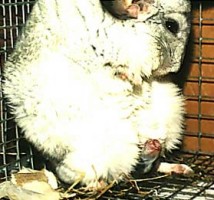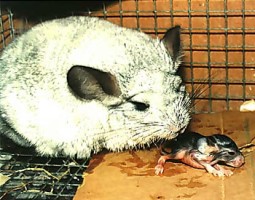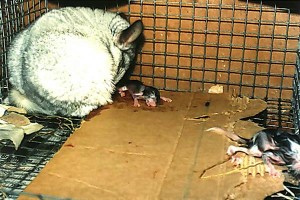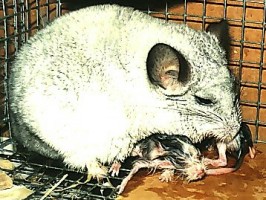Author Anjela Ross
Crystal Chinchillas
Chinchilla Birth
For all of you that are interested in breeding Chinchillas or are just fascinated at seeing a new baby Chinchilla coming into the world! Here are some photos that I have taken of one of my animals giving birth. She is a White and had been mated to a Standard and produced two healthy White Mosaic kits.
I have given up counting how many times people have said to me that they got up in the morning and the chinchilla had already given birth and the kits were dry, so I know that many of you miss out on this wonderful experience. So here to follow is an explanation of what is happening in each photo and five photos showing the main parts of the happy event!
When a Chinchilla goes into labour, she will be very quiet to start with and very still and often will sit in the corner of her cage trying to get some rest and does not wish to be disturbed. At this time when the contractions are becoming stronger she will be in a lot of pain and has to deal with this in the way she feels best. Sometimes it is possible to hear soft murmurs coming from her as the contractions get stronger. You may also see her rear up onto her hind legs and start cleaning her vagina and this will be open and often she will be cleaning up the birth fluid which may also be evident on the floor of the cage and also her fur around the vagina area will be wet.
After a while you will see the female sitting up on her hind legs and she it will be evident that she is starting to push the baby out, during this time, the female may begin to squeak quite loudly as she deals with the pain, often you will hear her grinding her teeth, this is also her way of dealing with the pain.

In this first photo, you can clearly see the female pushing out the baby and the head of the new arrival is out. At this stage the female will lean forward and clean away the birth sac from the face of the baby and lick and clean at the baby's face and make sure that the face is clean and the little one is able to breath.
She will then continue to push, until she manages to push the whole baby out. The pushing out of the baby can take various amounts of time varying from a few minutes for an experienced breeding female up to 10 or so minutes for a new mum.

At last she has pushed the new baby out and immediately begins to tend to it, licking at it and cleaning it. Nudging it and encouraging it to get on its feet. Once she has done this, she will then go back to cleaning at herself and pulling out any of the remaining birth sac that may still be inside her. She pulls this away with her teeth and usually eats this and then makes sure that she is clean. At this time the female may deliver an afterbirth. With Chinchillas they do not always have just one afterbirth, as with chinchillas they can have babies grow separately, so two kits, does not necessarily mean that they are twins. If two afterbirths are produced then you know that the two kits have grown separately, but if there is only one afterbirth, then it is safe to assume that the kits are twins.
The female has checked that the first baby is clean and is doing well and can now feel the contractions getting stronger again and starts to push and the second baby is now well on its way out.

Now the second baby is born, the mother again cleans the little one up and gets him on his feet and then starts to clean away at herself once again, making sure that all the birth sac is out of her.

As you can see the two new arrivals, are already on there feet, although wobbly and are starting to move about and explore the new world! While they are finding out where they are Mum is busy again cleaning at herself and once again starts pushing, in order that she can deliver her afterbirth. The afterbirth is not always found, as this small mound of flesh is usually eaten by the female as it is full of goodness. This goodness she will need over the next 7 to 8 weeks while she nurses and rears her two youngsters.

Now that she has delivered and eaten the afterbirth and the youngsters have done a little exploring, they come back to Mum and she continues to clean them off as they start to dry. She pushes the youngsters underneath her and encourages them to suckle from her and feel her warmth as she tends to them. During the first week, you do not get to see much of the new arrivals other than for a little exploration every now and then, they will stay tucked under Mum as they feed from her and keep warm. Over the next few weeks they will grow quite rapidly and will double in size very quickly.
At around the age of four weeks they start nibbling on hay and pellets, but the main food for them will be the Mothers milk. During this time it is imperative that the female gets plenty of food, in order that she can keep producing plenty of milk to enable her youngsters to grow well.
Then by the time the little ones are eight weeks old, they are fully weaned from Mum, although she may still encourage them to cuddle up to her and will still clean them, although at this age they are quite dependant of her and can be weaned away from her. The mother then can either take a rest on her own or can go back in with her Male for company.
|
|